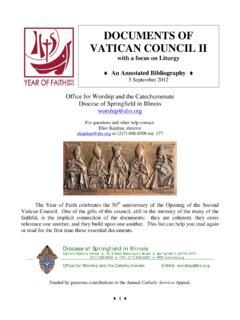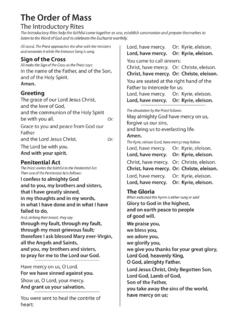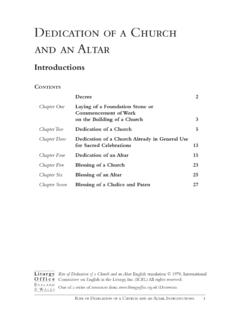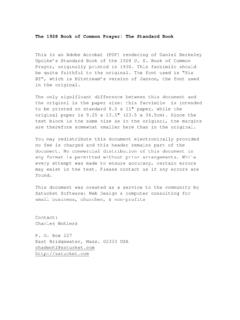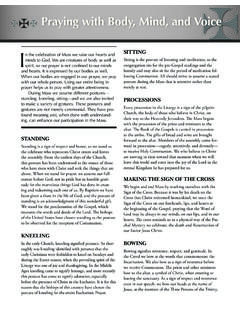Transcription of THE RITE OF ACCEPTANCE INTO THE ORDER OF …
1 THE RITE OF ACCEPTANCE INTO THE ORDER OF CATECHUMENS AND THE RITE OF WELCOMING THE CANDIDATES INSTRUCTION FOR CELEBRATING THE RITES INTRODUCTION The Rite of ACCEPTANCE into the ORDER of Catechumens (Rite of ACCEPTANCE ) is the first of the threshold rites of the Rite of Christian Initiation of Adults (RCIA), and the first public ritual. In the Rite of ACCEPTANCE , a change of identity takes place: those previously known as inquirers become catechumens. They are officially welcomed by the Church as disciples, members (albeit not yet full members) of the household of faith. The text calls this rite the first consecration by the Church 1 of those seeking Christian initiation. They are literally marked with the cross of Christ as God s own.
2 Consequently, the gathered community and its welcome, as well as the inquirers and their promise of discipleship, are essential to this rite. Except in extraordinary circumstances, it is celebrated at a Sunday Mass, so that the entire Christian an active part in the celebration. 2 Many Sundays in Ordinary Time are excellent choices because of their emphasis on themes of discipleship. The seasons of Christmas and Easter can also be good times to celebrate the rite. Lent should be avoided altogether, because of its emphasis on the Period of Purification and Enlightenment, and Advent because our focus is clearly elsewhere. The Rite of ACCEPTANCE should be celebrated several times in the course of the year.
3 When planning their annual calendar, each parish should fix at least two, and often three, times for celebrating this rite,3 so that as inquirers are deemed ready, they may be welcomed in a timely Before the Rite of ACCEPTANCE , it is crucial that there has been a sufficient precatechumenate period for each inquirer, and that discernment has taken place that they are ready for this The criteria for their readiness may be found in RCIA 42:6 1 RCIA, 41 2 RCIA, 45 3 RCIA, 18-19 4 Note here that, in addition to unbaptized inquirers, you will probably have candidates, already baptized in another denomination or even as a Catholic, who come to us with varying degrees of catechesis. As you approach these pre-set dates, part of the decision-making process will not only be the readiness of the inquirers and/or candidates, but also which of the rites will be celebrated, and at which Masses.
4 For an in-depth exploration of which rites to celebrate, visit AOB worship RCIA then Sorting it All Out. The Office of worship would also gladly offer advice on appropriate dates for scheduling these rites. 5 RCIA, 18, 43 6 Discernment of an inquirer s readiness is a crucial skill for an RCIA team. For a helpful discussion of the role of discernment, see the Foundations in Faith series, Precatechumenate Manual (Resources for 1 Evidence of first faith Intention to change their lives and enter into a relationship with Christ Evidence of the first stirrings of repentance A Start to the practice of calling upon God in prayer A sense of Church Some experience of the company and spirit of Christians (through contact with a priest or other members of the community).)
5 As with the other rites, in the celebration of the Rite of ACCEPTANCE , every effort should be made to make a clear distinction between catechumens (unbaptized persons who are seeking full Christian initiation, usually at the Easter Vigil) and candidates (persons already baptized usually in another Christian denomination who are uncatechized and seeking reception into the full communion of the Catholic Church7, as well as uncatechized Catholics seeking to complete their Christian initiation, through the sacraments of Confirmation and Eucharist). It is recommended -- as a way to make a clear distinction -- that parishes which celebrate multiple Masses on Sunday celebrate the Rite of ACCEPTANCE at one Mass, and the Rite of Welcoming the Candidates (for baptized but uncatechized adults) at another Mass or Masses.
6 Even in parishes with only one Sunday Mass, these rites could be celebrated on separate weekends. For extraordinary cases (such as for a family with both baptized and unbaptized persons), a Combined Rite is provided, but in this rite every attempt should be made to make clear distinctions (such as separate placement of catechumens and candidates). THREE OPTIONS Keeping in mind these considerations, the templates provided here offer three options for the Rite of ACCEPTANCE and Welcome: Christian Living, 1988), in particular pages 8 and 9. The Celebrating the Rites manual of the same series also provides an excellent summary of considerations on pages 18-19. For a more in-depth discussion of the role of discernment in the RCIA, see Discerning Disciples by Donna Steffen (Paulist Press, 1997).
7 7 We should make note that we also have baptized, catechized persons from other denominations, seeking full communion with the Catholic Church. Such persons will need a process of formation, but the duration depends upon the extent to which those persons have lived the Christian life. The National Statutes for the Catechumenate (NS) state that those baptized persons who have lived as Christians and need only instruction in the Catholic tradition and a degree of probation within the Catholic community should not be asked to undergo a full program parallel to the catechumenate (NS, 31, emphasis added). It is no accident that the RCIA does not specifically provide formation for baptized, catechized persons. The bias of the rite is that the baptized, catechized person needs a different type of formation altogether.
8 The National Statutes address this when they insist that those baptized in another Christian denomination should not be treated as catechumens: Their doctrinal and spiritual preparation for reception into full Catholic communion should be determined according to the individual case, that is, should depend on the extent to which the baptized person has led a Christian life within a community of faith and has been appropriately catechized to deepen his or her inner adherence to the Church (NS, 30). With this is mind, it would seem that baptized, catechized persons would not be the subjects of either the Rite of ACCEPTANCE or the Rite of Welcome. Again, see footnote # 4 for resources which will help you make these decisions.
9 2 A: Parish Rite of ACCEPTANCE into the ORDER of Catechumens B: Parish Rite of Welcoming the Candidates C: Parish (Combined) Rite of ACCEPTANCE into the ORDER of Catechumens and of the Rite of Welcoming Baptized but Previously Uncatechized Persons These templates are presented here only as a model of how individual parishes might celebrate these rites. Celebrations will be different from parish to parish, if for no other reason than physical space is a crucial factor in designing any ritual. Other important factors are the number of inquirers and the size of the assembly.
10 To celebrate these rites effectively, it is recommended that that the pastor, those responsible for liturgical preparation and the RCIA Coordinator form a rite planning team who will design the rite carefully, and produce your own leader s guide (script) similar to these templates. Working directly from the ritual book, with its multiple options and rubrics, is challenging in the best of circumstances. If you have a history of celebrating these rites in your parish, you are already on the way to establishing the relationship the rite calls for between the local parish and catechumens. To nurture this relationship continually, engage in a regular evaluation of your ritual practices by comparing your leader s guide to the actual ritual RCIA text and to these templates, and look for how well your ritual language is reflecting the intent of the original document.
